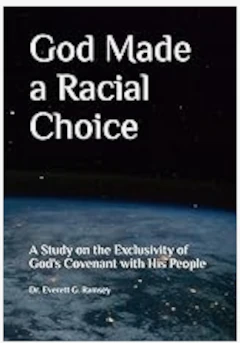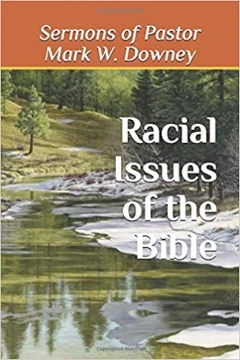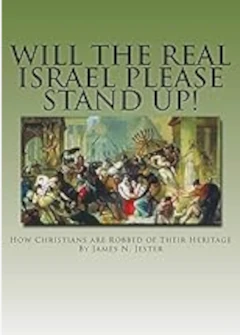R U Woke? Part 7
Chapter 38 of Genesis
Sermon notes by Jim Jester
February 13, 2022
Scripture Reading: Genesis 38:1-5
And it came to pass at that time, that Judah went down from his brethren, and turned in to a certain Adullamite, whose name was Hirah. 2 And Judah saw there a daughter of a certain Canaanite, whose name was Shuah; and he took her, and went in unto her. 3 And she conceived, and bare a son; and he called his name Er. 4 And she conceived again, and bare a son; and she called his name Onan. 5 And she yet again conceived, and bare a son; and called his name Shelah: and he was at Chezib, when she bare him.
Introduction
This sermon brings us to the conclusion of the Genesis portion of the series. Upon studying through the book of Genesis, we have often discovered areas that were not quite clear or lacked specificity. We could even say, a bit confusing. Most of this we observed in the first sermon of this series where we covered the Gap Theory and the Second Account Theory of mankind; and then in the fourth and fifth parts, the Curse of Ham theory. It seems that this anomaly occurs more in Genesis than any other book of the Bible. Why? Besides jewish tampering of the Masoretic Text; age-old Christian tradition says that Moses wrote the book of Genesis out of eleven ancient documents available in his day, probably handed down from generation to generation. Genesis is composed of:
The “Creation Hymn” (1:1-2:3)
The Generations of the Heavens and Earth (2:4-4:26)
The Generations of Adam (5:1-6:8)
The Generations of Noah (6:9-9:28)
The Generations of the Sons of Noah (10:1-11:9)
The Generations of Shem (11:10-26)
The Generations of Terah (11:27-25:11)
The Generations of Ishmael (25:12-18)
The Generations of Isaac (25:19-35:29)
The Generations of Esau (36:1-43)
The Generations of Jacob (37:2-50:26)
Perhaps this is part of the reason for translation problems and seemingly missing information and vagueness in the text. But just imagine working with old parchments, possibly damaged, that preserved family history over the centuries. Nevertheless, Moses did a fabulous job (guided by the hand of God) of putting the book together and interweaving family narratives with the genealogies. These eleven documents covered the first 2,000 years of man’s history from Adam to the settlement of the chosen people in Egypt. Yet, there are still those today who say there’s nothing in the Bible about race?
One more loose end I would like to tie in before we leave Genesis. Regarding the seduction of Eve, did she, or did she not, spawn the seed of the serpent through Cain? In Genesis 4:1, did she say “I have acquired a man from the Lord” meaning it literally? Or was she mistaken in thinking that God had now called upon her to fulfill the prophecy of Genesis 3:15 (the promised “Seed of the woman”). This would make sense if Gen. 4:1 is translated accurately. But is it, or has it been tampered with? There is evidence that it has been tampered with, and that the translation is not accurate. From an essay by Wm. Finck:
From the targum called pseudo-Jonathan: “And Adam knew that his wife Eve had conceived from Sammael the Angel (of death) and she became pregnant and bore Cain. And he was like those on high and not like those below. And she said: ‘I have got a man from the angel of the Lord’.” While this interpretation of Gen. 4:1 may not be exactly as the original, which we may never have, it surely does reflect the belief of many of the common people of Judaea around the time of Christ; and they must have gotten their ideas from some Scripture which they had at one time possessed. Other early targums contain similar interpretations of Gen. 4:1, and the Hebrew text of that verse, as we have it in the Masoretic Text, is known by scholars to be corrupt (q.v., The Interpreter’s Bible, vol. 1, p. 517).
[Before Eve was taken by Satan] Further examples of this are found in other apocryphal books. For instance, in Brenton’s Septuagint, at 4 Maccabees 18:7-8, we find a woman who is obviously being compared to Eve: “7 And the righteous mother of the seven children spake also as follows to her offspring: I was a pure virgin, and went not beyond my father’s house; but I took care of the built-up rib. 8 No destroyer of the desert, [or] ravisher of the plain, injured me; nor did the destructive, deceitful, snake, make spoil of my chaste virginity; and I remained with my husband during the period of my prime.”
Likewise, in another ancient writing, The Protevangelion, which gives an account of Joseph and Mary in the days leading up to the birth of Christ, in chapter 10, upon Joseph’s learning that Mary had become pregnant without his marriage to her having yet been consummated, he is portrayed as having exclaimed: “5 Is not the history of Adam exactly accomplished in me? 6 For in the very instant of his glory, the serpent came and found Eve alone, and seduced her. 7 Just after the same manner it has happened to me...” Other statements similar to these are found in other apocryphal writings, yet it should be quite evident that many of the people of Judaea believed that someone other than Adam had fathered Cain (as John the apostle also believed, q.v. 1 John 3:12; and Christ Himself, q.v. John 8:44), and that this someone was a “serpent”, one of those fallen angels of Rev. 12:7-9. (The Problem with Genesis 6, by Wm. R. Finck; emphasis mine)
Genesis 38
“And Judah saw there a daughter of a certain Canaanite, whose name was Shuah; and he took her, and went in unto her.” (Gen. 38:2) Thus begins Judah’s affair with a Canaanite woman who bore him Er, Onan, and Shelah. God killed Er and Onan, but Shelah remained. This leads to the next major event in Judah’s life.
Then said Judah to Tamar his daughter in law, ‘Remain a widow at thy father’s house, till Shelah my son be grown:’ for he said, ‘Lest peradventure he die also, as his brethren did.’ (Gen. 38:11)
Bible commentators have long wondered why the story of Judah’s sexual encounter with Tamar was inserted, almost as a parenthesis, into the main story of Joseph, which runs from Genesis 37 and continues through chapters 39-45. Chapter 38 seems to be out of place and very unusual.
Adam Clarke comments on this chapter:
Genesis 38:1, “And it came to pass at that time” — The facts mentioned here could not have happened at the times mentioned in the preceding chapter, as those times are all unquestionably too recent, for the very earliest of the transactions here recorded must have occurred long before the selling of Joseph. Mr. Ainsworth remarks “that Judah and his sons must have married when very young, else the chronology will not agree. For Joseph was born six years before Jacob left Laban and came into Canaan; Gen. 30:25, and Gen. 31:41. Joseph was seventeen years old when he was sold into Egypt, Gen. 37:2, Gen. 37:25; he was thirty years old when he interpreted Pharaoh’s dream, Gen. 41:46. And nine years after, when there had been seven years of plenty and two years of famine, did Jacob with his family go down into Egypt, Gen. 41:53, Gen. 41:54, and Gen. 45:6, Gen. 45:11. And at their going down thither, Pharez, the son of Judah, whose birth is set down at the end of this chapter, had two sons, Hezron and Hamul, Gen. 46:8, Gen. 46:12. Seeing then from the selling of Joseph unto Israel’s going down into Egypt there cannot be above twenty-three years, how is it possible that Judah should take a wife, and have by her three sons successively, and Shelah the youngest of the three be marriageable when Judah begat Pharez of Tamar, Gen. 38:14, Gen. 38:24, and Pharez be grown up, married, and have two sons, all within so short a space? The time therefore here spoken of seems to have been soon after Jacob’s coming to Shechem, Gen. 33:18, before the history of Dinah, Genesis 34, though Moses for special cause relates it in this place.” I should rather suppose that this chapter originally stood after Genesis 33, and that it got by accident into this place. (Adam Clarke Commentary)
Clarke makes sense, but I doubt if the story of Judah “got by accident into this place” because Moses wanted to keep the genealogy in chronological order. To move this history of Judah from the history of his father, Jacob, would mean his history would be placed under his grandfather, Isaac (“before the history of Dinah, Genesis 34”). However, the narrative of Judah could have been placed at chapter 37 verse 2 (or the contents of 36 & 38 switched). This way Judah’s history would be under his father, and the remainder of Genesis would conclude with Joseph and the Israelites in Egypt. But although it stands now slightly out of place, perhaps it is meant to capture our attention.
Barnes informs us of the age of Judah at various events in his life:
- 13 years 6 months when Er was born.
- 14 years 4 months when Onan was born.
- 15 years 3 months when Shelah was born.
- 28 years 9 months when Pharez was born.
- 42 years 3 months when Hezron was born to Pharez.
- 43 years 2 months when Hamul was born.
Besides the willfulness of Judah, it seems the command to be “fruitful and multiply” (q.v., Gen. 35:11), which was given especially to Jacob, may have had a tendency to encourage early marriages.
But whatever the details may have been, this chapter was ultimately placed in holy writ to trace another part of the chosen family, i.e., not all Israelites were in Egypt (as Joseph) at this time. Not only does Genesis 38 tell us of Judah marrying a Canaanite woman and which sons were born by her; it also tells us which sons were born by Tamar because of their sexual encounter.
The story of Joseph is interrupted at this point, for the purpose of giving some particulars concerning the family history of Judah. This account is not to be considered merely as a sordid event, but rather as a parallel history, all belonging to the wider history of the sons of Israel. Tamar’s son, Pharez, provided the royal line of King David (and Jesus). Pharez was the firstborn and his name means breach or breakthrough. Truly, it is ironic that this chapter is a “breach” in the story of Joseph. Even the name Pharez is a clue as to why this chapter is in this particular location. The Bible wants us to know who is who in the history of the world.
The Affair
Genesis 38:12-19;
And in process of time the daughter of Shuah Judah’s wife died; and Judah was comforted, and went up unto his sheep-shearers to Timnath, he and his friend Hirah the Adullamite. 13 And it was told Tamar, saying, Behold thy father in law goeth up to Timnath to shear his sheep. 14 And she put her widow’s garments off from her, and covered her with a vail, and wrapped herself, and sat in an open place, which is by the way to Timnath; for she saw that Shelah was grown, and she was not given unto him to wife. 15 When Judah saw her, he thought her to be an harlot; because she had covered her face. 16 And he turned unto her by the way, and said, Go to, I pray thee, let me come in unto thee; (for he knew not that she was his daughter in law.) And she said, What wilt thou give me, that thou mayest come in unto me? 17 And he said, I will send thee a kid from the flock. And she said, Wilt thou give me a pledge, till thou send it? 18 And he said, What pledge shall I give thee? And she said, Thy signet, and thy bracelets, and thy staff that is in thine hand. And he gave it her, and came in unto her, and she conceived by him. 19 And she arose, and went away, and laid by her vail from her, and put on the garments of her widowhood.
The sons from Judah’s Canaanite wife, Shuah, could not be part of the chosen family. God killed the two mixed breed sons, Er and Onan (q.v., Gen. 38:7-10). The remaining son, Shelah, was also illegitimate. Judah was afraid to offer his third son, after what had happened to his first two sons; and besides, he was too young. Eventually, some of the Shelahites became the forefathers of the jews that Jesus faced in the New Testament.
The covenant promises only applied to the racial descendants of Abraham through Isaac and Jacob. The twin sons born by Tamar were of good seed because both Tamar and Judah were of pure Israelite descent. Most of the descendants of Pharez stayed with the tribe of Judah. The descendants of Zarah went in different directions. Some stayed with the tribe but some traveled to Western Europe and Britain and became known as the “Celts” having been from Chaldea.
Most Bible commentators say that Tamar was a prostitute, or harlot, thus discrediting her character. This is not true. The Bible does not say she was a harlot; it says in verse 15, “when Judah saw her, he thought she was a harlot.” Later, in verse 21, the question was asked, “Where is the harlot who was in full view by the roadside?” And they said, “There was no harlot in this place.” Now, if there truly were a harlot in the area, everyone should have known about her.
What was Tamar to do in order to have children? Great women should want to carry on their race. It is a shame and terrible sin that so many White girls marry “a person of color.” This is an increasing problem in America and “wokeism” is being pushed into our schools. God does not recognize such a “marriage;” and He will not tolerate it for long.
Judah did not fulfill his promise to give Tamar a husband. Therefore, she finally took matters into her own hands. Even Judah remarked, “She has been more righteous than I.” (v. 26) We should also remember that Tamar’s arranged marriage was never consummated and therefore, she was a free woman according to the law. Furthermore, because she conceived by good seed, God’s law did not consider her adulterous. If she had married one of the Canaanite men in the area, then she would have been truly adulterous, because “mixing of seed” is the core meaning of the word adulterate. She laid her reputation on the line and took the chance of being assumed an adulteress, along with its death penalty. In so doing, she became the ancestress of the royal family.
Judah on Trial
Genesis 38:24-26
And it came to pass about three months after, that it was told Judah, saying, Tamar thy daughter in law hath played the harlot; and also, behold, she is with child by whoredom. And Judah said, Bring her forth, and let her be burnt. 25 When she was brought forth, she sent to her father in law, saying, By the man, whose these are, am I with child: and she said, Discern, I pray thee, whose are these, the signet, and bracelets, and staff. 26 And Judah acknowledged them, and said, She hath been more righteous than I; because that I gave her not to Shelah my son. And he knew her again no more.
The Other Exodus
Genesis 38:27-30
And it came to pass in the time of her [Tamar’s] travail, that, behold, twins were in her womb. 28 And it came to pass, when she travailed, that the one put out his hand: and the midwife took and bound upon his hand a scarlet thread, saying, This came out first. 29 And it came to pass, as he drew back his hand, that, behold, his brother came out: and she said, How hast thou broken forth? This breach be upon thee: therefore his name was called Pharez. 30 And afterward came out his brother, that had the scarlet thread upon his hand: and his name was called Zarah.
Some of the descendants of Zarah settled the Iberian Peninsula before moving on to Northern Ireland. You will not see this in the history books, but that part of southern Europe called Iberia or Hibernia was named after the Eber (q.v., Gen. 10:21) of the Bible. Polybius (q.v., The Histories III.6.2, Bill Thayer) states that the “native name” of the peninsula is Iber. Eber is also the origin of the word Hebrew.
Many of these Zarahites settled in the islands of Britain around 1550 B.C., fifty-seven years before the Exodus (1493 B.C.) of the main body of Israelites from Egypt! The account of the birth of Tamar’s twins tells us that a hand came out and the midwife identified the firstborn (Zarah) by tying on a red string. Then the hand went back in and Pharez came out instead, thus he was the firstborn. The Zarahites settled in Ireland and became part of the prophecy that kings would come from Judah. Part of their heritage is seen today in the flag of Ulster. The flag is a cross with a Red Hand in the center! Kings have used a red ribbon to tie letters, and we have the phrase “red tape” today.
Tamar was a heroine. Because of her actions, she provided the royal line of descendants to Jesus Christ (q.v., Matt. 1:3). She was one of the four women (Tamar, Rahab, Ruth, Bathsheba) mentioned in Matthew’s account, besides Mary who bore the Christ. In addition, her descendants through Zarah became the founders of Troy and later Britain. According to Dr. Blanchard’s Identifying Biblical Israel Today, p. 4, Darda, the great-grandson of Zarah, “established the city of Troy in approximately 1527 BC, which would have been thirty-four years before the Exodus.” (The date for the Exodus being 1493 BC.) Easton’s Commentary says 1490 BC, and the Chronological Bible, 1446 BC.
Cheated of their birthright, the descendants of Zarah [those left] separated from the children of Israel soon after the Exodus. This separation explains why so few references to Zarah appear in God’s Word. Some of the children of Zarah went north to Greece. Others went to Troy, near the Dardanelles, which by the way bears the name of Zarah’s fifth son, Darda. After Troy’s fall to the Achaeans (Greeks), a group of Zarahites under the leadership of Brutus migrated to Britain via Malta. In England, they founded New Troy, which the Romans much later renamed Londinium, now London.
Other Zarahites settled down in Ireland, after residing for a time in Spain, where they founded the city of Saragossa, literally, the City of Zarah. By the time of David, a princely clan of Zarahites was established as Ireland’s royal family, ruling a part of the tribe of Dan, the Tautha de Danaan (i.e., the tribe of Dan) of Irish legend, which had also settled there. (Forerunner Commentary, Dan, Charles Whitaker)
As to Pharez and his descendants, we can assume most stayed with the tribe of Judah. According to McClintock and Strong Bible Cyclopedia:
Pharez seems to have kept the right of primogeniture over his brother, as, in the genealogical lists, his name comes first. The house also which he founded was far more numerous and illustrious than that of the Zarhites. Its remarkable fertility is alluded to in Ruth 4:12: “Let thy house be like the house of Pharez, whom Tamar bare unto Judah.” Of Pharez’s personal history or character nothing is known. We can only speak of him therefore as a demarch [a political step], and exhibit his genealogical relations. At the time of the sojourn in the wilderness “the families of the tribe of Judah were: of Shelah, the family of the Shelalites, or Shilonites; of Pharez, the family of the Pharzites; of Zerah, the family of the Zarhites. And the sons of Pharez were, of Hezron, the family of the Hezronites, of Hamul, the family of the Hamulites” (Nu. 26:20-21). After the death therefore, of Er and Onan without children, Pharez occupied the rank of Judah’s second son, and, moreover, from two of his sons sprang two new chief houses, those of the Hezronites and Hamulites. From Hezron’s second son Ram, or Aram, sprang David and the kings of Judah, and eventually Jesus Christ. …
The house of Caleb was also incorporated into the house of Hezron, and so were reckoned among the descendants of Pharez. Another line of Pharez's descendants were reckoned as sons of Manasseh by the second marriage of Hezron with the daughter of Machir (1 Ch. 2:21-22). In the census of the house of Judah contained in 1 Chronicles 4, drawn up apparently in the reign of Hezekiah (1 Ch. 4:41), the houses enumerated in verse 1 are Pharez, Hezron, Carmi, Hur, and Shobal. Of these all but Carmi (who was a Zarhite, Jos. 7:1) were descendants of Pharez. …
In the reign of David the house of Pharez seems to have been eminently distinguished. The chief of all the captains of the host for the first month, Jashobeam, the son of Zabdiel (1 Ch 27:2-3), so famous for his prowess (1 Ch. 11:11), and called “the chief among the captains” (ibid. and 2 Sa. 23:8), was of the sons of Perez, or Pharez. …
That the family of Pharez continued to thrive and multiply we may conclude from the numbers who returned from captivity. At Jerusalem alone 468 of the sons of Perez, with Athaiah, or Uthai, at their head, were dwelling in the days of Zerubbabel (1 Ch. 9:4; Ne. 11:4-6), Zerubbabel himself of course being of the family (1 Esdr. 5:5).
Many centuries later, at the time of the fall of Jerusalem, the breach in the family of Judah was closed by God’s providence:
The marriage of one of Zedekiah’s daughters—of the Perez branch of Judah—to a prince of the Zerah branch healed the breach in Judah’s family. Through this healing, God 1) perpetuated the Davidic monarchy, as required by the unconditional promise to David in II Samuel 7:16. The offspring of the Irish prince and Zedekiah’s daughter would legitimately bring the two branches together indefinitely, as one family, one monarchy; 2) maintained the authority of the Davidic monarchy over the “house of Israel,” as God prophesied in Jeremiah 33:17. Jeremiah received the job of transporting the royal couple back to Ireland. (Forerunner Commentary)
The Character of Judah
The chief points of Judah’s character:
FAITHLESSNESS TOWARD GOD — This is seen, 1. In his separation from his brethren (Gen. 38:1). This was an act of willful indiscretion, and dangerous to his spiritual interests. He leaves the family where God was known and honored, and forms a close friendship with a Canaanite. 2. In his marriage with a Canaanite (Gen. 38:2). He had objected to his sister’s marriage with Shechem, and yet he marries this woman, and without consulting his father. Such connections as these were forbidden to the covenant family, who were to be a separated people. Judah was the first of Israel’s sons to take this wrong path.
A STRONG SENSUAL NATURE — He had already become heathenish by his unlawful connections with Canaanites and was easily seduced. This is illustrated by his intercourse with Tamar (q.v., Gen. 38:12-18).
A GOOD SENSE OF JUSTICE — Judah had not sunk to the lowest depths of degradation in which the conscience is seared, and where there is no concern for righteousness. He did not hesitate to acknowledge his guilt, and the superior sense of justice shown by Tamar (q.v., Gen. 38:26). “He now acknowledges that in withholding his son from the widow and denying her right, he had brought about this shameful event. It is evident from the narrative that she was driven to this scheme, not from lewdness, but to obtain through Judah himself, the covenant posterity of which he was wrongfully depriving her.” (Jacobus) Judah also had enough sense of religious obligation to maintain the customs (and law of God) of the covenant family, which were ordained for its preservation (q.v., Gen. 38:8).
SELF DEPENDENCE — Judah was of strong character. He would rush without thinking things through; but had the power in him for evil or for good.
Conclusion
The racial implications that applied to the ancient Israelites in Genesis, also applies to the modern Israelites of today. I would say to the judeo-Christian world; the racial meaning of Genesis ought to be obvious. Your leaders, such as the famous Billy Graham, have told you there is nothing in the Bible about race. But the Bible is full of race! Are you biblically awake? Or have you joined the wokeism movement?
From our moral point of view, we may question this “illicit” pregnancy in the lineage of Jesus. However, it is here that no apology is offered. Is it not peculiar, that no racial background of Tamar is mentioned, while the racial background of Shua is mentioned? Why? Because Shua is out of character with the Bible. Tamar is not out of character because she represents the norm of the covenant family to pick wives for their sons, of the correct race. As was customary, Judah selected Tamar for his eldest son from among the daughters of his brothers (all Israelite). Fortunately for her, this choice (although technically correct) was thwarted by Er’s death. In God’s view, Tamar was as racially pure as was Abraham, Isaac, Jacob and Judah before her (Was she from Bethel or Padanaram? Where most of the family was from).
God had his hand in this matter by prohibiting offspring from the two sons (Er, Onan). Perhaps He wants to show how His purposes can overrule man’s errs and sins. Judah in his own flesh, choosing Shuah as wife; but God, not wanting Shuah to have anything to do with the genealogy leading to His Son, making Tamar His choice. And so by this roundabout process, God brings Tamar into the picture so that her son (Pharez) will be the one who has a place in the lineage of Christ.
What are the lessons of Judah’s history?
That God’s cause has the seeds of triumph even when it seems to fail. Judah appears to be lost — the hope of his posterity gone for ever. The tribe seems to be cut off, but the purpose of God shall still be accomplished. Likewise in the cross, the cause of Christ seemed to fail; His life and teaching, a pleasant memory; or an unusual chapter of enthusiasm. But, in the design of God and in actual result, it was the hour of His triumph. Thereby, He was “the power of God, and the wisdom of God.” (I Cor. 1:24.)
This history has relevance to God’s purpose in salvation; that Christ sprang from the tribe of Judah. In regard to God’s redeeming purpose, this history reveals: 1. That God’s election is by grace. Otherwise, Judah would not have been the ancestor of Christ. 2. It shows the native glory of Christ. He derives all His glory from Himself, not from His ancestry. 3. It shows the condescension of Christ. The most shameful sinners are found in His genealogy. He “despised the shame,” and “made Himself of no reputation.” Luther asks, “Why did God the Holy Ghost permit these shameful things to be written? Answer: That no one should be proud of his own righteousness and wisdom; and, again, that no one should despair on account of his sins. It also may be to remind us that by natural right, Gentiles too, are the mother, brothers, and sisters of our Lord.”
Luther may not have realized this, but, it can be shown from Scriptural context that the Gentiles are the former ten tribes of Israel, thus they too are the covenant people of God, even though they had forgotten and lost the knowledge of their identity.












